News

March 30, 2016
MU Scientists Fighting World Hunger
By Bobby Remis | MU Bond Life Sciences Center Sanborn Field, University of Missouri | photo by Kyle Spradley In the years to come, climate change and population growth will drastically alter the world around us, impacting farmland and the way we grow food. Scott Peck, associate professor of biochemistry, studies how plants perceive and respond to changes in their environment. New research from an interdisciplinary team at the University of Missouri is hoping to curb the decrease in food production due to climate change by studying the roots of corn…

March 15, 2016
Climate change to heat up discussion at annual LSSP symposium
By Jennifer Lu | MU Bond Life Sciences Center Thinkstock by Getty Images Climate change is a pressing issue. Just last week, the National Academies of Sciences, Engineering and Medicine published a report linking climate change to extreme weather conditions such as heat waves, droughts, and heavy snows and rains. Globally, 2015 was the warmest year on record, according to climate updates from the National Oceanic and Atmospheric Administration. And January kicked off this year by logging temperatures exceeding those of all previous Januaries on record, a disturbing trend that’s persisted for nine…
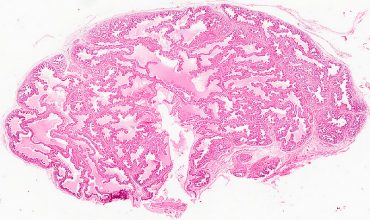
March 15, 2016
Seminal work
How unruly data led MU scientists to discover a new microbiome By Roger Meissen | MU Bond Life Sciences Center This seminal vesicle contains a newly-discovered microbiome in mice. Some of its bacteria, like P. acnes, could lead to higher occurrences of prostate cancer. | contributed by Cheryl Rosenfeld It’s a strange place to call home, but seminal fluid offers the perfect environment for particular types of bacteria. Researchers at MU’s Bond Life Sciences Center recently identified new bacteria that thrive here. “It’s a new microbiome that hasn’t been looked…
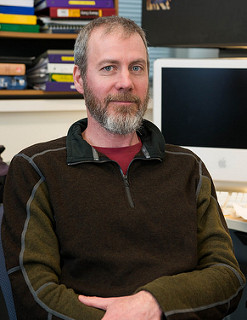
March 8, 2016
Rodents of unusual appetites
How food cravings and eating affects the brain By Jennifer Lu | MU Bond Life Sciences Center When it comes to cookie dough, we’re not the only ones who can’t control our cravings. Kyle Parker’s rats couldn’t resist, either, thanks to a tweak in their brain chemistry. Parker studies the neuroscience of food-based rewards. Matthew Will, associate professor of psychological sciences at the Bond Life Sciences Center, studies the neuroscience of behaviors such as over-eating and addiction | photo by Jennifer Lu, Bond LSC “It’s like when I eat dessert after I’ve eaten an entire meal,” said Parker,…

March 1, 2016
Unmasking the unknown
Scientists explore genetic similarities between plants and mice University of Missouri PhD Candidate Daniel L. Leuchtman peers through an Arabidopsis plant. Leuchtman has been experimenting with replacing a gene in the plants immune system with a similar gene from mice. | Photograph by Justin L. Stewart/MU Bond Life Sciences Center By Justin L. Stewart | MU Bond Life Sciences Center Almost two-thirds of what makes a human a human and a fly a fly are the same, according to the NIH genome research institute. If recent research at the University of Missouri’s Bond…
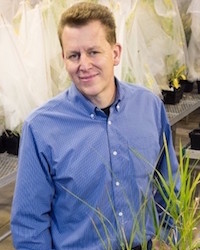
Jan. 26, 2016
Bond Life Sciences Center Scientists Named to Thomson Reuters’ 2015 List of Highly Cited Researchers
By Bobby Remis | MU Bond Life Sciences Center You can imagine it’s hard to distinguish yourself from the crowd when it comes to scientific papers. But, publishing quality work in a well-known journal adds value to the whole scientific world by assisting others and inspiring new science. Three Bond LSC researchers recently were recognized for doing just that. Bond Life Sciences Center scientists Chris Pires, Shuqun Zhang and Yidong Liu are among five University of Missouri System researchers named in the 2015 Thomson Reuters’ Highly Cited Researchers list. This list spotlights the top 1 percent of papers published from nearly…
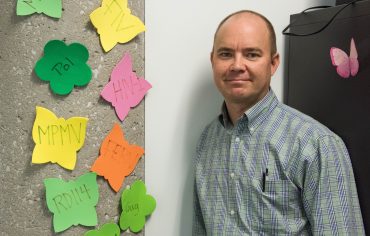
Nov. 25, 2015
You shall not pass: the basic science of blocking HIV
Marc Johnson, associate professor of molecular microbiology and immunology at the Bond Life Sciences Center, studies viruses such as HIV. | photo by Jennifer Lu, Bond LSC Nineteen colorful foam flowers decorate the walls of Marc Johnson’s office, a memento from his lab members when they “redecorated” while he was out of town. Each flower is labeled in bold Sharpie with the names of viruses and viral proteins that his lab studies—MLV, RSV, Gag, Pol, to name a few. One flower stands out, marked in capital letters: H-I-V. Johnson, an associate professor of molecular microbiology…
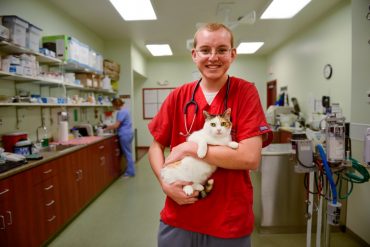
Nov. 3, 2015
Family genes
MU freshman follows in aunt’s footsteps while exploring career options Robert Schmidt poses with one of the cats that lives at Horton Animal Hospital, where he works part-time. Schmidt, a freshman studying biochemistry at the University of Missouri, is a member of the Discovery Fellows Program where he is learning about plant genetics by working with biologist Scott Peck in the Bond Life Sciences Center. Photo by Justin L. Stewart | MU Bond Life Sciences Center By Justin L. Stewart | MU Bond Life Sciences Center Sometimes it’s socks. Another time, it was a book cover.

Oct. 21, 2015
Putting down roots
Plant scientist Ruthie Angelovici joins the Bond Life Sciences Center By Jennifer Lu | MU Bond Life Sciences Center Ruthie Angelovici Ruthie Angelovici clearly remembers her big eureka moment in science thus far. It didn’t happen in a laboratory. It wasn’t even her experiment. At the time, Angelovici was in college studying marine biology. She had spent a year going on diving trips to figure out whether two visibly different corals were polymorphs of the same species, or two separate species. A simple DNA test told her the answer in one afternoon. “That’s the day I decided…
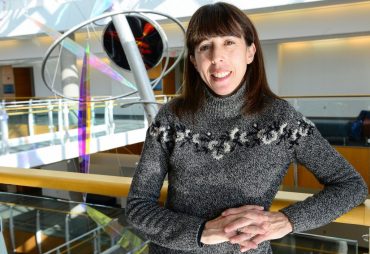
Oct. 20, 2015
Maze Runners
Female rats struggle to find their way in BPA study from MU and the NCTR/FDA Cheryl Rosenfeld is one of 12 researchers partnering with the NCTR/FDA to study BPA Despite concerns about bisphenol A (BPA), academic and regulatory scientists have yet to reach a consensus on BPA’s safety. The National Institute of Environmental Health Sciences (NIEHS), the National Toxicology Program (NTP), the Food and Drug Administration and independent university researchers are working together to change that. Five years after the Consortium Linking Academic and Regulatory Insights on BPA Toxicity, or CLARITY-BPA for short, launched, results are…

Oct. 8, 2015
Understanding spit
Scientists find how nematodes use key hormones to take over root cells Roger Meissen | MU Bond Life Sciences Center This Arabidopsis root shows how the beet cyst nematode activates cytokinin signaling in the syncytium 10 days after infection. The root fluoresces green when the TCSn gene associated with cytokinin activation is turned on because it is fused with a jellyfish protein that acts as a reporter signal. Contributed by Carola De La Torre This is a story about spit. Not just any spit, but the saliva of cyst nematodes, a parasite that literally sucks away billions in profits from…
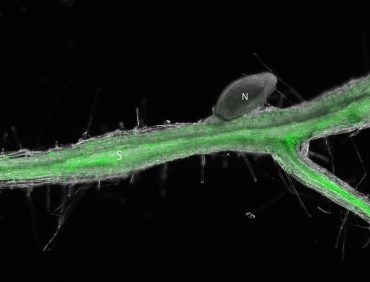
Oct. 8, 2015
Understanding spit
Scientists find how nematodes use key hormones to take over root cells Roger Meissen | Bond Life Sciences Center This Arabidopsis root shows how the beet cyst nematode activates cytokinin signaling in the syncytium 10 days after infection. The root fluoresces green when the TCSn gene associated with cytokinin activation is turned on because it is fused with a jellyfish protein that acts as a reporter signal. (N=nematode; S=Syncytium). Contributed by Carola De La Torre This is a story about spit. Not just any spit, but the saliva of cyst nematodes, a parasite that literally sucks…